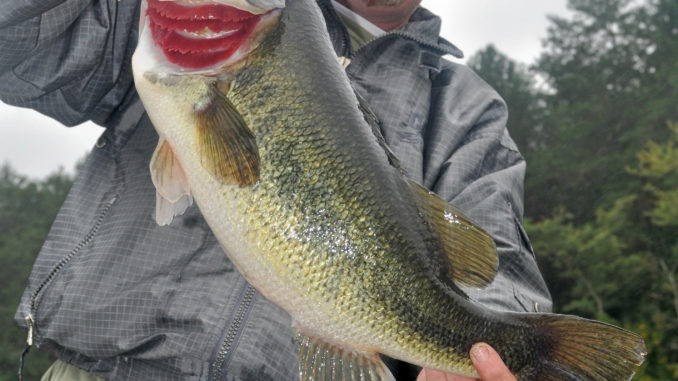
When bass start to move shallow, Tucketown fishermen can load their livewells.
The first stop one day last May was Rick’s Restaurant in Denton. It’s a place where loggers, retirees, office workers, telephone linemen, cops, truckers and yes, fishermen, gather for the finest country breakfast in the southern half of Davidson County: scrambled eggs, ham, sausage or bacon, flapjacks, plenty of biscuits or buttered toast, jam, and waitresses who make sure to keep your mug filled with steaming coffee. They’ll even fix you any kind of biscuit you want to take before you walk out the door.
Except for the large white lettering on the green, drop-down awning slapped around its flat roof and the same name on its brick facade, Rick’s looks just like hundreds of southern restaurants — a square building with painted white parking spaces in an asphalt lot.
The exterior tells you little about what’s inside — just like Tuckertown Lake.
For a many fishermen who’ve fished the entire Yadkin River chain of lakes, Tuckertown has the most-variable and suitable habitats to find largemouth bass. Sandwiched between two bigger and more-publicized lakes —High Rock to the north and Badin to the south, Tuckertown has qualities that many anglers believe combine the best of those two impoundments.
Sections of Tuckertown have steep bluffs — where college and high-school kids cliff-jump each summer — and wide shallow coves with acres of matted water lily pads. Other coves feature moderate depths and woody structure along their shorelines: — blowdowns, stumps and stickups.
But best of all, the lake is filled with baitfish, mostly gizzard and threadfin shad. That means a lot of well-fed gamefish and Tuckertown has largemouth and spotted bass, striped bass, catfish, crappie and bluegills and, believe it or not, a smattering of walleyes.
Brian Shinn, 44, is a native of Kannapolis who lives in Garner. He also is a former tournament bass fishermen who discovered he’d rather spend time with his family on weekends than haul a bass boat around and fish competitively.
“I looked for a place where I could bring my family and fish, and I found this piece of property at Tuckertown Lake seven years ago,” he said.
After fishing the lake sporadically, he wanted to find some places he could depend upon to hold largemouths, so he turned to guide Maynard Edwards of Lexington.
A former business teacher who put in 28 years at Central Davidson High School before retiring in 2012, Edwards, 62, made his guiding bones at High Rock Lake, but Tuckertown was one of the first lakes where he refined his bass-fishing techniques.
“The best baits in May at this lake are Senkos, Sluggos or Fluke-style soft plastics, four to six inches long,” said Edwards “That’s for fishing the really shallow water. If you’re fishing woody structure or rocks, I like a 1/2-ounce Carl Benton-model light-wire spinnerbait with an R-bend hook and … gold and silver willow-leaf blades.”
Shinn prefers to use a 7-foot baitcasting rod with a reel spooled with 12-pound Sufix or Cajun monofilament.
“I stick mostly with watermelon-color, soft-plastic Senkos or Sluggos,” he said. “I also like to throw buzzbaits in May, especially early in the morning at stickups, blowdowns or around stumps.”
Because he no longer worries about bringing bass to a tournament’s scales, Shinn said he is able to use lighter line.
“I don’t worry about break-offs anymore because I’m not tournament fishing,” he said. “The funny thing is, I think I catch more bass because of the lighter, harder-to-see line. I might lose a few, but I end up catching more fish. You can catch a big fish with 12-pound line; just don’t horse him.”
Anglers have basically two choices at Tuckertown to look for bass each spring: staging areas in five to eight feet of water, or along shorelines after fish move to the banks to start the spawn.
“Good places to fish shallow … are ones that show pea gravel,” Edwards said. “If you don’t know exactly where good spawning places are, just go down the bank with a trolling motor and look for rocks or gravel on the shoreline. Most of the time, that bottom will extend out into the lake.
“Then there are the shallow-water lily pads. The backs of some of the coves are just wrapped up in that stuff. I think bass not only go into the lily pads before they go to the banks to spawn, but I think they hang out there a lot of the time.”
Lily pad mats are perfect cover for bass, which are ambush predators, and they offer protection to baitfish.
“The thing you got to remember is it takes an entirely different outfit to fish lily pads than open water,” said Edwards, who recommends using a flipping stick and a reel spooled with at least 40-pound line.
He likes to use plastic lures that imitate rats or frogs that are designed to be fished weedless. Numerous manufacturers produce these kinds of lures, which are made to be fished along the surface over pads or matted vegetation.
“The technique is pretty simple,” said Edwards, who said white is the most effective color for both classes of lures. “You use a flippin’ stick with 40- to 50-pound mono and flip the frog into the pads and sort of ‘semi-jerkbait’ retrieve it back to you. Make the frog stop on pads that have clearings, then hop it off the pad into the water.
“Bass like to hide under lily pads and know when something lands on top of them. You’ll have some of the most vicious topwater blow-ups you’ve ever seen. But don’t jerk (the rod tip) right away. You have to feel the weight of a bass with the lure in his mouth before you rear back and try to cross his eyes. If you jerk too quick, you’ll just pull the lure out of his mouth.
“If your line gets wrapped, don’t try to horse him out; you’ll often pull the hooks out of a bass’s mouth. Put down the trolling motor and go get him. If a bass misses, throw right back at the spot. If you don’t get a bite, you can come back later and try the same place. He’ll be hangin’ around somewhere near.”
Bass typically begin spawning the first week or two of May, according to Edwards, who changes lures.
“If they’re on the beds, that’s when I like a floating worm,” he said.
That’s most likely to happen the first week or two of May, depending upon weather and water temperature. If April was cold, the spawn often delays until mid-May.
However, bedding bass are difficult to catch, especially large, egg-laden “sow” females. The male bass that guard the nests are much easier to catch because it’s their jobs to guard eggs and fry. Once the female lays her eggs, she retreats toward deeper water. The males are hard-wired to serve guard duty until the fry get large enough to disperse.
Edwards said his clients like to catch bass, no matter the time of year, even if it means snatching the male nurses out of the maternity ward. So he hands his anglers baitcasting outfits rigged with floating worms — pink and sherbert are favorite colors).
“You just cast into a bed and jiggle it,” he said. “A male bass — and sometimes they can weigh 3 1/2 to 4 pounds — will pick them up.”
Females are more selective and have to be tricked into biting.Shinn likes to use a 3/8-ounce jig on light line for bedding lunkers. The technique he and Edwards use is to throw a jig with the skirt-trimmed short past a bed where they’ve seen a fish they want. The water has to be clear enough to allow them to see the fish.
“You want the bass to be looking elsewhere when you drop the lure behind her, then you snatch it past her really quick so she can’t see it or pick it up,” Edwards said.
This cast-and-snatch scenario should be repeated about 10 times. Each time an angler does it, sometimes even brushing a bass’s flanks with the jig, she’ll get more agitated and finally mad enough to bite.
“When she’s spinning around like a top, trying to figure out where the thing that’s pestering her is going to appear next, that’s when you drop the lure in front of her nose and shake it once,” Edwards said. “Most of the time they’ll blast it.”
DESTINATION INFORMATION
WHEN TO GO/HOW TO GET THERE — Tuckertown is part of the Yadkin River system, downstream from High Rock and upstream from Badin, serving as much of the border between Davidson County on the east and Rowan County on the west. Part of the lake downstream from the NC 49 bridge is in Montgomery County. The lake is best accessed via NC 49 from the east or west and US 52 and NC 8 and NC 109 from north or south. The most-popular public boat ramp is just west of the NC 49 bridge on the lower end of the 2,500-acre lake.
TACKLE/TECHNIQUES — Medium-action baitcasting outfits spooled with 17-pound mono and a 2-foot leader of 17-pound fluorocarbon are preferred for casting Senkos, Sluggos or Flukes in open water. When fishing lily pads with artificial frogs or rats, switch to flipping sticks and extremely heavy line. When bass move to the shoreline to spawn, go back to the medium-action rods and fish floating worms.
FISHING INFO/GUIDES — Maynard Edwards, Yadkin Lakes Guide Service, Lexington, 336-249-5782, www.ExtremeFishingConcepts.com. See also Guides and Charters in Classifieds.
ACCOMMODATIONS — Best Western, Albemarle, 855- 499-0001; Comfort Inn, Asheboro, 336-626-4414; HWY 8 Motel, Lexington, 336-357-6444; Rowan County Chamber of Commerce, Salisbury, 704-633-4221, www.rowanchamber.com.
MAPS — Gemini Maps, Charlotte, 704- 846-1833; DeLorme’s North Carolina Atlas & Gazetteer, 800-452-5931, www.delorme.com.

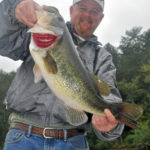
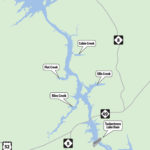
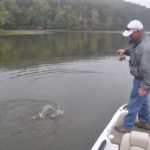
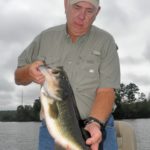




Be the first to comment